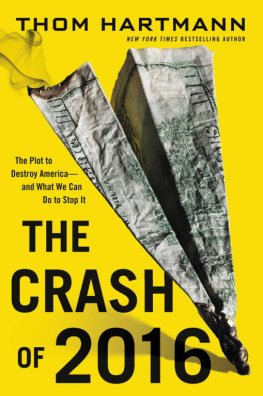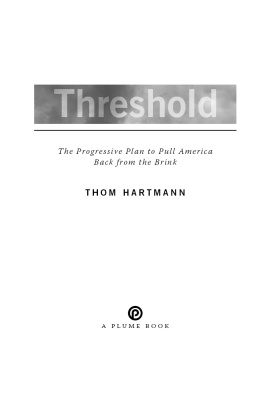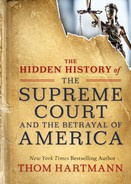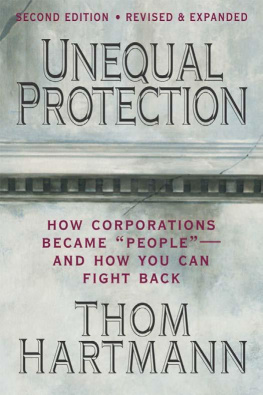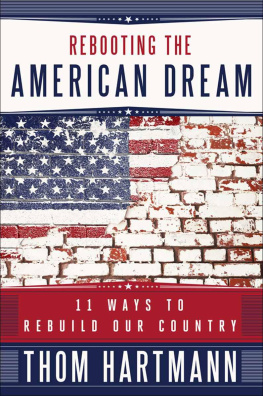Rebooting the American Dream
Also by Thom Hartmann
Unequal Protection: How Corporations Became Peopleand How You Can Fight Back
Threshold: The Crisis of Western Culture
Cracking the Code: How to Win Hearts, Change Minds, and Restore Americas Original Vision
Screwed: The Undeclared War against the Middle Classand What We Can Do about It
What Would Jefferson Do?: A Return to Democracy
The Last Hours of Ancient Sunlight: The Fate of the World and What We Can Do Before Its Too Late
Ultimate Sacrifice: John and Robert Kennedy, the Plan for a Coup in Cuba, and the Murder of JFK
Legacy of Secrecy: The Long Shadow of the JFK Assassination
We the People: A Call to Take Back America
Walking Your Blues Away: How to Heal the Mind and Create Emotional Well-being
Attention Deficit Disorder : A Different Perception
Thom Hartmanns Complete Guide to ADHD: Help for Your Family at Home, School and Work
Healing ADD : Simple Exercises That Will Change Your Daily Life
The Edison Gene: ADHD and the Gift of the Hunter Child
ADD Success Stories: A Guide to Fulfillment for Families with Attention Deficit Disorder
Think Fast: The ADD Experience
Beyond ADD: Hunting for Reasons in the Past and Present
ADHD Secrets of Success: Coaching Yourself to Fulfillment in the Business World
The Prophets Way: A Guide to Living in the Now
The Greatest Spiritual Secret of the Century
Rebooting the American Dream
11 Ways to Rebuild Our Country
Thom Hartmann

Rebooting the American Dream
Copyright 2010 by Mythical Research, Inc., and Thom Hartmann.
All rights reserved. No part of this publication may be reproduced, distributed, or transmitted in any form or by any means, including photocopying, recording, or other electronic or mechanical methods, without the prior written permission of the publisher, except in the case of brief quotations embodied in critical reviews and certain other noncommercial uses permitted by copyright law. For permission requests, write to the publisher, addressed Attention: Permissions Coordinator, at the address below.

| Berrett-Koehler Publishers, Inc.
235 Montgomery Street, Suite 650
San Francisco, California 94104-2916
Tel: (415) 288-0260, Fax: (415) 362-2512
www.bkconnection.com |
Ordering information for print editions
Quantity sales. Special discounts are available on quantity purchases by corporations, associations, and others. For details, contact the Special Sales Department at the Berrett-Koehler address above.
Individual sales. Berrett-Koehler publications are available through most bookstores. They can also be ordered directly from Berrett-Koehler: Tel: (800) 929-2929; Fax: (802) 864-7626; www.bkconnection.com
Orders for college textbook/course adoption use. Please contact Berrett-Koehler: Tel: (800) 929-2929; Fax: (802) 864-7626.
Orders by U.S. trade bookstores and wholesalers. Please contact Ingram Publisher Services, Tel: (800) 509-4887; Fax: (800) 838-1149; E-mail: customer.service@ingrampublisherservices.com; or visit www.ingrampublisherservices.com/Ordering for details about electronic ordering.
Berrett-Koehler and the BK logo are registered trademarks of Berrett-Koehler Publishers, Inc.
First Edition
Hardcover print edition ISBN 978-1-60509-706-0
PDF e-book ISBN 978-1-60509-909-5
IDPF e-book ISBN 978-1-60509-943-9
2010-1
Cover/jacket Designer: Ian Shimkoviak/The Book Designers
Interior design and composition by Gary Palmatier, Ideas to Images
Elizabeth von Radics, copyeditor; Mike Mollett, proofreader; Medea Minnich, indexer.
DEDICATION
To our daughters, Kindra and Kerith,
who are coincidentally both back in school
and rebooting their own lives.
May the world you inherit be as rich in wonder and
opportunity as the world into which your parents were born.
Thank you both for being such wonderful, caring,
and honorable human beings, so dedicated to
healing the world one person at a time.
Contents
Introduction:
Back to the Future
I know no safe depository of the ultimate powers of the society but the people themselves; and if we think them not enlightened enough to exercise their control with a wholesome discretion, the remedy is not to take it from them, but to inform their discretion by education. This is the true corrective of abuses of constitutional power.
Thomas Jefferson, letter to William
Charles Jarvis, September 28, 1820
ON APRIL 14, 1789, GEORGE WASHINGTON WAS OUT WALKING through the fields at Mount Vernon, his home in Virginia, when Charles Thomson, the secretary of the Continental Congress, rode up on horseback. Thomson had a letter for Washington from the president pro tempore of the new, constitutionally created United States Senate, telling Washington that hed just been elected president and the inauguration was set for April 30 in the nations capital, New York City.
This created two problems for Washington.
The first was saying goodbye to his 82-year-old mother, which the 57-year-old Washington did that night. She gave him her blessing and told him it was the last time hed see her alive, as she was gravely ill; and, indeed, she died before he returned from New York.
The second problem was finding a suit of clothes made in America. For that he sent a courier to his old friend and fellow general from the American Revolutionary War, Henry Knox.
Washington couldnt find a suit made in America because in the years prior to the American Revolution, the British East India Company (whose tea was thrown into Boston Harbor by outraged colonists after the Tea Act of 1773 gave the worlds largest transnational corporation a giant tax break) controlled the manufacture and the transportation of a whole range of goods, including fine clothing. Cotton and wool could be grown and sheared in the colonies, but it had to be sent to England to be turned into clothes.
This was a routine policy for England, and it is why until India achieved its independence in 1947 Mahatma Gandhi (who was assassinated a year later) sat with his spinning wheel for his lectures and spun daily in his own home. It was, like his Salt March, a protest against the colonial practices of England and an entreaty to his fellow Indians to make their own clothes to gain independence from British companies and institutions.
Fortunately for George Washington, an American clothing company had been established on April 28, 1783, in Hartford, Connecticut, by a man named Daniel Hinsdale, and it produced high-quality woolen and cotton clothing as well as items made from imported silk. It was to Hinsdales company that Knox turned, and he helped Washington getin time for his inauguration two weeks latera nice, but not excessively elegant, brown American-made suit. (He wore British black later for the celebrations and the most famous painting.)
When Washington became president in 1789, most of Americas personal and industrial products of any significance were manufactured in England or in its colonies. Washington asked his Treasury secretary, Alexander Hamilton, what could be done about that, and Hamilton came up with an 11-point plan to foster American manufacturing, which he presented to Congress in 1791. By 1793 most of its points had either been made into law by Congress or formulated into policy by either President Washington or the various states, which put the country on a path of developing its industrial base and generating the largest source of federal revenue for more than a hundred years.
Next page




